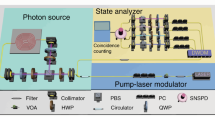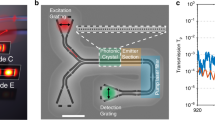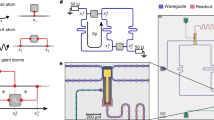Abstract
Photonic chips that integrate optical elements on a single device can process vast amounts of information rapidly. A new branch of this technology involves coupling light to cold atoms or Bose–Einstein condensates, the quantum nature of which provides a basis for new information-processing methods. The use of optical waveguides gives the light a small cross-section, making coupling to atoms1,2 efficient. In this Letter, we present the first waveguide chip designed to address a Bose–Einstein condensate along a row of independent junctions, which are separated by only 10 µm and have large atom–photon coupling. We describe a fully integrated, scalable design, and demonstrate 11 junctions working as intended, using a low-density cold atom cloud with as little as one atom on average in any one junction. The device suggests new possibilities for engineering quantum states of matter and light on a microscopic scale.
This is a preview of subscription content, access via your institution
Access options
Subscribe to this journal
Receive 12 print issues and online access
$209.00 per year
only $17.42 per issue
Buy this article
- Purchase on Springer Link
- Instant access to full article PDF
Prices may be subject to local taxes which are calculated during checkout




Similar content being viewed by others
References
Horak, P. et al. Possibility of single-atom detection on a chip. Phys. Rev. A 67, 043806 (2003).
Bajcsy M. et al. Efficient all-optical switching using slow light within a hollow fiber. Phys. Rev. Lett. 102, 203902 (2009).
Fortágh, J. & Zimmermann, C. Magnetic microtraps for ultracold atoms. Rev. Mod. Phys. 79, 235–289 (2007).
Reichel, J. & Vuletic, V. Atom Chips (Wiley-VCH, in the press).
Seidelin, S. et al. Microfabricated surface-electrode ion trap for scalable quantum information processing. Phys. Rev. Lett. 96, 253003 (2006).
André, A. et al. A coherent all-electrical interface between polar molecules and mesoscopic superconducting resonators. Nature Phys. 2, 636–642 (2006).
Jaksch, D., Briegel, H.-J., Cirac, J. I., Gardiner, C. W. & Zoller, P. Entanglement of atoms via cold controlled collisions. Phys. Rev. Lett. 82, 1975–1978 (1999).
Chen, S. et al. Deterministic and storable single-photon source based on a quantum memory. Phys. Rev. Lett. 97, 173004 (2006).
Gleyzes, S. et al. Towards a monolithic optical cavity for atom detection and manipulation Eur. Phys. J. D 53, 107–111 (2009).
Cirac, J. I. & Zoller, P. Quantum computations with cold trapped ions. Phys. Rev. Lett. 74, 4091–4094 (1995).
DeMille, D. Quantum computation with trapped polar molecules. Phys. Rev. Lett. 88, 067901 (2002).
Politi, A., Cryan, M. J., Rarity, J. G., Yu, S. & O'Brien, J. L. Silica-on-silicon waveguide quantum circuits. Science 320, 646–649 (2008).
Yang, W. et al. Atomic spectroscopy on a chip. Nature Photon. 1, 331–335 (2007).
Knappe, S. et al. A microfabricated atomic clock. Appl. Phys. Lett. 85, 1460–1462 (2004).
Pollock, S., Cotter, J. P., Laliotis, A. & Hinds, E. A. Integrated magneto-optical traps on a chip using silicon pyramid structures. Opt. Express 17, 14109–14114 (2009).
Quinto-Su, P., Tscherneck, M., Holmes, M. & Bigelow, N. On-chip optical detection of laser cooled atoms. Opt. Express 12, 5098–5103 (2004).
Eriksson, S. et al. Integrated optical components on atom chips. Eur. Phys. J. D 35, 135–139 (2005).
Takamizawa, A., Steinmetz, T., Delhuille, R., Hänsch, T. W. & Reichel, J. Miniature fluorescence detector for single atom observation on a microchip. Opt. Express 14, 10976–10983 (2006).
Wilzbach, M. et al. Simple integrated single-atom detector. Opt. Lett. 34, 259–261 (2009).
Colombe, Y. et al. Strong atom–field coupling for Bose–Einstein condensates in an optical cavity on a chip. Nature 450, 272–276 (2007).
Trupke, M. et al. Atom detection and photon production in a scalable, open, optical micro-cavity. Phys. Rev. Lett. 99, 063601 (2007).
Dayan, B. et al. A photon turnstile dynamically regulated by one atom. Science 319, 1062–1065 (2008).
Aoki, T. et al. Efficient routing of single photons by one atom and a microtoroidal cavity. Phys. Rev. Lett. 102, 083601 (2009).
Hope, J. J. & Close, J. D. General limit to nondestructive optical detection of atoms. Phys. Rev. A 71, 043822 (2005).
Abraham, E. R. I. & Cornell, E. A. Teflon feedthrough for coupling optical fibers into ultrahigh vacuum systems. Appl. Opt. 37, 1762–1763 (1998).
Yu, D. F. & Fessler, J. A. Mean and variance of single photon counting with deadtime. Phys. Med. Biol. 45, 2043–2056 (2000).
Acknowledgements
The authors acknowledge valuable discussions with B. Darquié, the assistance of G. Lepert with fibre coupling, and the technical expertise of J. Dyne, S. Maine and V. Gerulis, without whom the apparatus could not have been constructed. We acknowledge UK support by the Engineering and Physical Sciences Research Council (EPSRC), the Quantum Information Processing Interdisciplinary Research Collaboration (QIPIRC) and the Royal Society, and European Union support through Scalable Quantum Computing with Light and Atoms (SCALA) and Hybrid Information Processing (HIP).
Author information
Authors and Affiliations
Contributions
R.A.N., M.S., M.K. and P.G.P. constructed the apparatus, maintained the experiment, and took and analysed the data. M.T. and M.K. designed, specified and assembled the waveguide chip. E.A.H. was the principal investigator and also co-wrote the manuscript with R.A.N. All authors commented on the manuscript and discussed the construction, data, its analysis and interpretation.
Corresponding authors
Ethics declarations
Competing interests
The authors declare no competing financial interests.
Rights and permissions
About this article
Cite this article
Kohnen, M., Succo, M., Petrov, P. et al. An array of integrated atom–photon junctions. Nature Photon 5, 35–38 (2011). https://doi.org/10.1038/nphoton.2010.255
Received:
Accepted:
Published:
Issue Date:
DOI: https://doi.org/10.1038/nphoton.2010.255
This article is cited by
-
Prospects for strongly coupled atom-photon quantum nodes
Scientific Reports (2019)
-
Photonic waveguide to free-space Gaussian beam extreme mode converter
Light: Science & Applications (2018)
-
Contactless nonlinear optics mediated by long-range Rydberg interactions
Nature Physics (2017)
-
Ultrafast Ramsey interferometry to implement cold atomic qubit gates
Scientific Reports (2014)
-
Optical Interface for Bose-Einstein Condensates Using Permanent Magnetic Traps and Cavity QED
Journal of Low Temperature Physics (2014)



